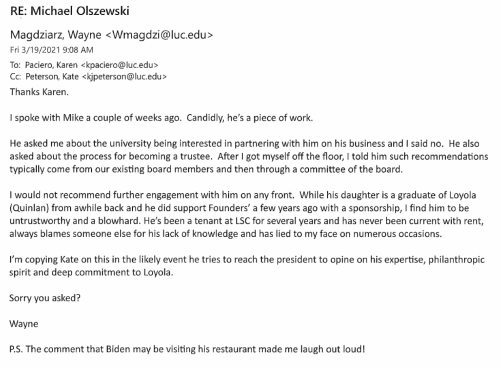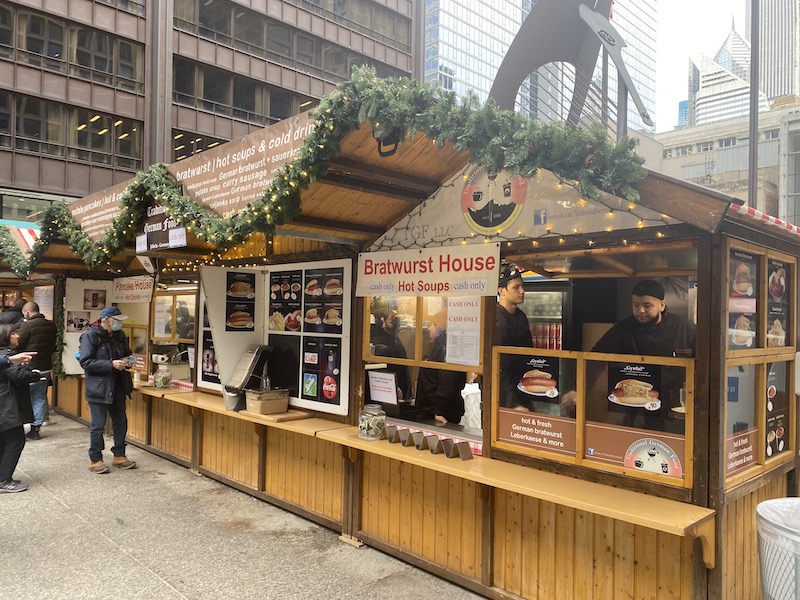1. RIP BRIAN MITA
Brian Mita, co-owner (with his mom) and chef of Izakaya Mita in Bucktown, who had been fighting cancer for two and a half years, passed away this weekend. He was 43; the restaurant had just reopened in October. I just went a few weeks ago, right after it reopened, and although it’s not exactly the Japanese (or even the New York) idea of an izakaya, I always found it perfectly pleasant for a taste of Japanese favorites with a corner bar, everybody’s-glad-you-came feel. Here’s a video his family posted about him.
2. SAYONARA YOSHI’S
Yoshi’s Cafe, one of the city’s few chef-owned high end establishments when it opened in 1982 serving French-Asian cuisine, is closing. Chef Yoshi Katsumura passed away in 2015 but his widow, Nobuko, and son Ken continued to operate it (another child is Mari Katsumura, who most recently was chef of Yügen). The Tribune has more on the history of the restaurant here.
3. SWEET!
Sweet Bean is a Taiwanese cafe in the South Loop and “a great place to grab a matcha latte and a cream puff for the road. But if you have some time to linger, delicious dumplings and noodles await,” says an un-bylined Time Out reviewer:
The highlight of my mid-afternoon stop at Sweet Bean was an order of the Shanghai-style soup dumplings, which arrived at my table in a bamboo steam basket. With a juicy, chicken filling (pork is also available) wrapped in a tender, doughy shell, these dumplings were as good as any that I’ve sampled just down the Red Line in Chinatown—and just as tricky for me to eat without the aid of a spoon.
4. THE GREAT DEBAGEL
Nick Kindelsperger responds to comments about his nouvelle bagel roundup a couple of weeks ago—that the bagels he cited were expensive, too hard to get, and too not named New York Bagel & Bialy.
5. DRINK ITALIAN
David Hammond talks to Formento somm Chuckiy Bement about Italian wine:
Consumers are intimidated by Italian wines. So many regional differences and dozens of varietals make buyers apprehensive. Most people enjoy consistency and knowing what they’re getting when they buy a wine, so they usually opt for a Chianti, Nebbiolo, Pinot Grigio or Prosecco. I think my advice to consumers is to not be afraid of Italian wines! This is a country that has drunk wine casually for generations and has only been making serious wine since the 1970-1980s. Most varietals and styles of Italian wines are very approachable, though many of the wines that consumers are told to buy can be the most intimidating.
6. CHOCOBUCHA PIE
Steve Dolinsky talks to three women entrepreneurs—kombucha maker Bridget Connelly of Luna Bay, Maya-Camille Broussard of Justice of the Pies, and Pam Vieau of Chocolate Inspirations—about their paths into making holiday-friendly food and drink.
7. ANNA BANANA
I’ve been in Chinatown’s Saint Anna Bakery, just walked by it yesterday as it happens, but don’t have particular feelings about it. Titus Ruscitti says why attention should be paid:
There was a time not long ago when most of the spots in Chinatown were similar to Saint Anna Bakery. It’s the type of place you’re likely to run into some of the neighborhoods longest tenured residents. It’s the Chinatown equivalent of a typical neighborhood diner on Main St. People come here for socializing as much as the food but they’re here for that too.
Saint Anna is a bakery and a cafe. It’s most popular hours are in the morning due to the fact they make some convenient breakfast pastries and they also serve food and hot drinks. It’s a classic Cantonese style Hong Kong cafeteria. I could totally picture this place somewhere in a local HK neighborhood.
He also visits an izakaya in Schaumburg, Torizen:
The tendon at Torizen is as good as it gets (outside of Japan) but the ramen seems to be their biggest draw. I decided to stop by and try it not too long ago while in the area. They make a Sapporo style miso ramen and get the noodles imported from Japan. Much like with pizza I’m not akin to all the buzz words that Ramen Heads like to use to describe a satisfying bowl of ramen, aren’t most bowls satisfying? At least when they’re made by places like this?
I was looking for somewhere to order sandwiches for the fam the other day and looked at Big Kids—but with only four items on the menu, and none of them the veggie greens and grilled cheese that was my favorite in the summer, I tried somewhere else (the always excellent JT’s Sandwich, as it happened). Seems weird to me that as a pop-up becomes permanent, the menu shrinks rather than the opposite. Anyway Titus went to it, too:
You can expect to find TMNT memorabilia on the walls and songs like Scooby Snacks from the Fun Lovin Criminals on the jukebox. This place is so hipster it almost feels like a parody of an imaginary Portland sandwich shop. The menu is just as playful as the rest of the operation and it’s really well played. Big Kids has managed to stand out in a sea of sandwich shops around town with it’s creative offerings like the Chicago Philly Chee. Shaved steak is griddled with caramelized beef jus onions, giardiniera, garlic mayo and provolone on garlic bread. A sandwich fit for a misfit. Delicious.
8. VAMEUX
I had a pretty good meal at Venteux, in Michigan Ave.’s Carbide & Carbon Building, but the experience was chaotic enough that we were joking about how long chef Donald Young (Temporis) would last there, always a question with hotel restaurants. And the winner is, until late November, when he announced his departure on Facebook.
9. PARLOR VOUS INVESTIGATION?
Parlor Pizza Bar in the West Loop can’t seem to stay out of bad publicity—now the city is investigating them for “allegations that workers were not paid for overtime work, that employees were sexually harassed and that customers were discriminated against based on their race and/or age.” Block Club has more.
10. $15 AN HOUR IN THE MATRIX
Robots are cooking in an Indian food court in Naperville:
This is how it works: When an order comes in, the robot gathers the pans and utensils needed for the meal prep. It then accesses the ingredients needed from a smart cabinet holding 15 to 18 spice containers, six types of meats and 24 types of vegetables and from a dispenser containing 14 types of liquid.
Just as any human chef would do, the robotic arm adds and mixes ingredients, sets stove flame levels, and removes and plates completed orders.
What really matters is what they don’t do like a human chef—call in sick, do blow during shift, ask for a living wage…
11. JI YOU’RE SWELL
On Amuzed, Michael Muser and Pat Kiely talk to the delightful Ji Suk Yi, of Windy City Live, the Sun-Times, and other things.
12. FULL OF GRACE
Remember Michael Olszewski, the developer who owned Grace and, when it imploded, opened Yügen in the same space? He had, for a time, another restaurant up near Loyola, called Onward, but it seems to have closed around the time of the initial lockdown (nobody paid that much attention to it). Well, now it’s making some news—at least in the legal newspaper Cook County Record. In July the paper ran a story headlined “Onward restaurant owner says Loyola University shut him down over COVID, now seeking to evict him with no recourse”:
According to the complaint, Loyola asserts Onward owes more than $268,000 in back rent, and hasn’t paid its $10,000 per month rent since September 2019….
But Onward’s owner Michael Olszewski has responded in court, saying there is more to this story….
According to his July 14 motion, Olszewski expressed misgivings to Loyola officials over the chances of successfully operating such an upscale restaurant in the East Rogers Park neighborhood.
He particularly noted other development activities pursued by Loyola in that neighborhood had engendered hostility from some neighbors over concerns about “gentrification.”
However, the motion said Olszewski “answered the call of Loyola, his alma mater” and personally invested $1.5 million into the project, despite his concerns.
What a noble guy! Note, however, that while many restaurateurs faced troubles with rent after COVID hit, Olszewski apparently stopped paying his landlord seven months before other restaurants closed for the virus.
A story followed in October, headlined “Onward restaurant owner countersues Loyola in eviction fight, says university owes him for eviction shutdown”:
The counterclaim details Olszewski’s personal seven-figure investment in the project and levels allegations against Loyola, as landlord, for breaching lease terms and causing construction delays of more than three months. Among the issues were failing to build a wall dividing Onward and Argo Tea, an unsecure site that resulted in the theft of Onward’s plans and materials. Olszewski further accused Loyola for failing to reimburse Onward for the loss of those materials and the loss in value of rent during the lease’s first year.
Then COVID hit and the university forced him to close (by forcing him, apparently, to follow state and city law at that point):
[Olszewski] argued Loyola’s refusal to allow him to reopen and attempt to earn money to pay the demanded rent, should be grounds for a “complete abatement” of rent for Onward.
The defamation complaint targets Wayne Magdziarz, Loyola’s senior vice president, chief financial officer and chief business officer, as well as David Beall, associate vice president of business operations.
This is why Olszewski is a visionary—other restaurateurs just tried to get out of paying rent during lockdown, a position one can certainly be sympathetic with, but only Olszewski would say the landlord owes him for all that time!
This is where it gets juicy. As a legal paper, Cook County Record links directly to the court filings from both sides (good question: why haven’t regular newspapers been doing this for years already?) And emails between Loyola staffers about Olszewski were entered into the public record because they’re part of Olszewski’s counterclaims are that he was libeled in them. So we get to read this private but official correspondence, and… well, it’s more fun to read than you’d expect for business correspondence from a university:


(You can see all this and more by following this link to the complaint, and then scrolling way down to Exhibit A.) And remember, we get to read these because Olszewski found them in discovery and made them part of the record.


